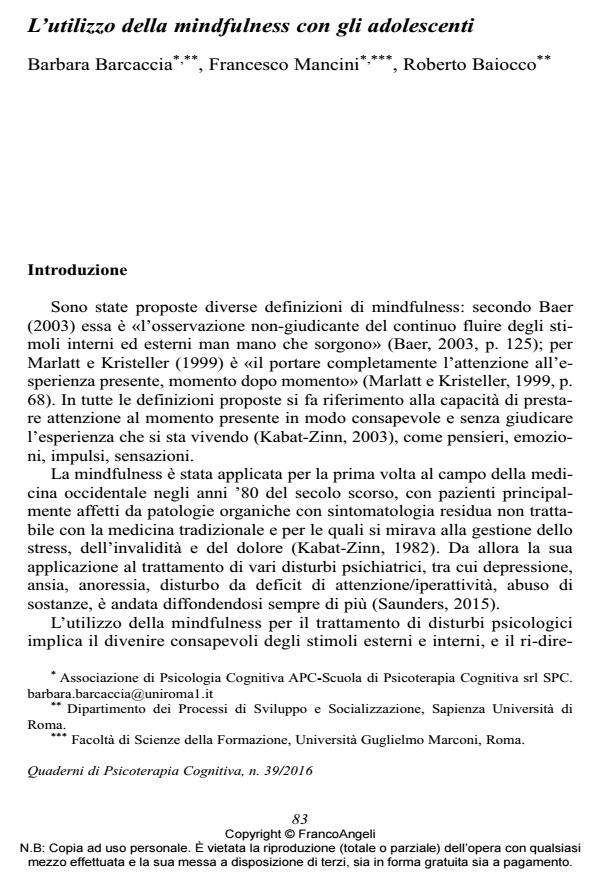Using mindfulness practices with adolescents
Journal title QUADERNI DI PSICOTERAPIA COGNITIVA
Author/s Barbara Barcaccia, Francesco Mancini, Roberto Baiocco
Publishing Year 2016 Issue 2016/39
Language Italian Pages 16 P. 83-98 File size 113 KB
DOI 10.3280/QPC2016-039006
DOI is like a bar code for intellectual property: to have more infomation
click here
Below, you can see the article first page
If you want to buy this article in PDF format, you can do it, following the instructions to buy download credits

FrancoAngeli is member of Publishers International Linking Association, Inc (PILA), a not-for-profit association which run the CrossRef service enabling links to and from online scholarly content.
In the last few years, the use of mindfulness for the treatment of psychological problems in childhood and adolescence has significantly increased: both in externalising and in internalising disorders teaching kids to let go of their mental contents, whether they be depressive, anxious or aggressive thoughts, proves to be effective. Particularly, a mindful disposition is correlated with lower levels of psychopathology, when compared to adolescents with high dispositional mindfulness. Moreover, there is some encouraging data for the treatment of mental disorders in this age range. Nevertheless, the available research data denote the need for ongoing research that adheres to more rigorous study designs, besides the increase in the number of studies, in order to enhance the evaluation of mindfulness practices for adolescents. Regarding the adaptation of practices, it is useful to propose a variety of different exercises, in order to avoid boredom and disengagement. In addition, some practices should be tailor-made for this age group, such as the mindful use of one’s smartphone, or mindful listening to music. The duration of each practice should also adapted, by reducing the length to approximately ten minutes, depending on the case. The acquisition of mindfulness skills seems to be a core competence for adolescents, in order to better manage impulsivity, modulate emotions, reduce opposition to unwanted negative emotions, increase their acceptance, and at the same time increase the capacity of experiencing and noticing positive emotions. Mindfulness practices could represent an innovative and effective element to manage and reduce both externalising and internalising symptomatology in adolescence.
Keywords: Mindfulness, adolescents, adaptation of practices
Barbara Barcaccia, Francesco Mancini, Roberto Baiocco, L’utilizzo della mindfulness con gli adolescenti in "QUADERNI DI PSICOTERAPIA COGNITIVA" 39/2016, pp 83-98, DOI: 10.3280/QPC2016-039006